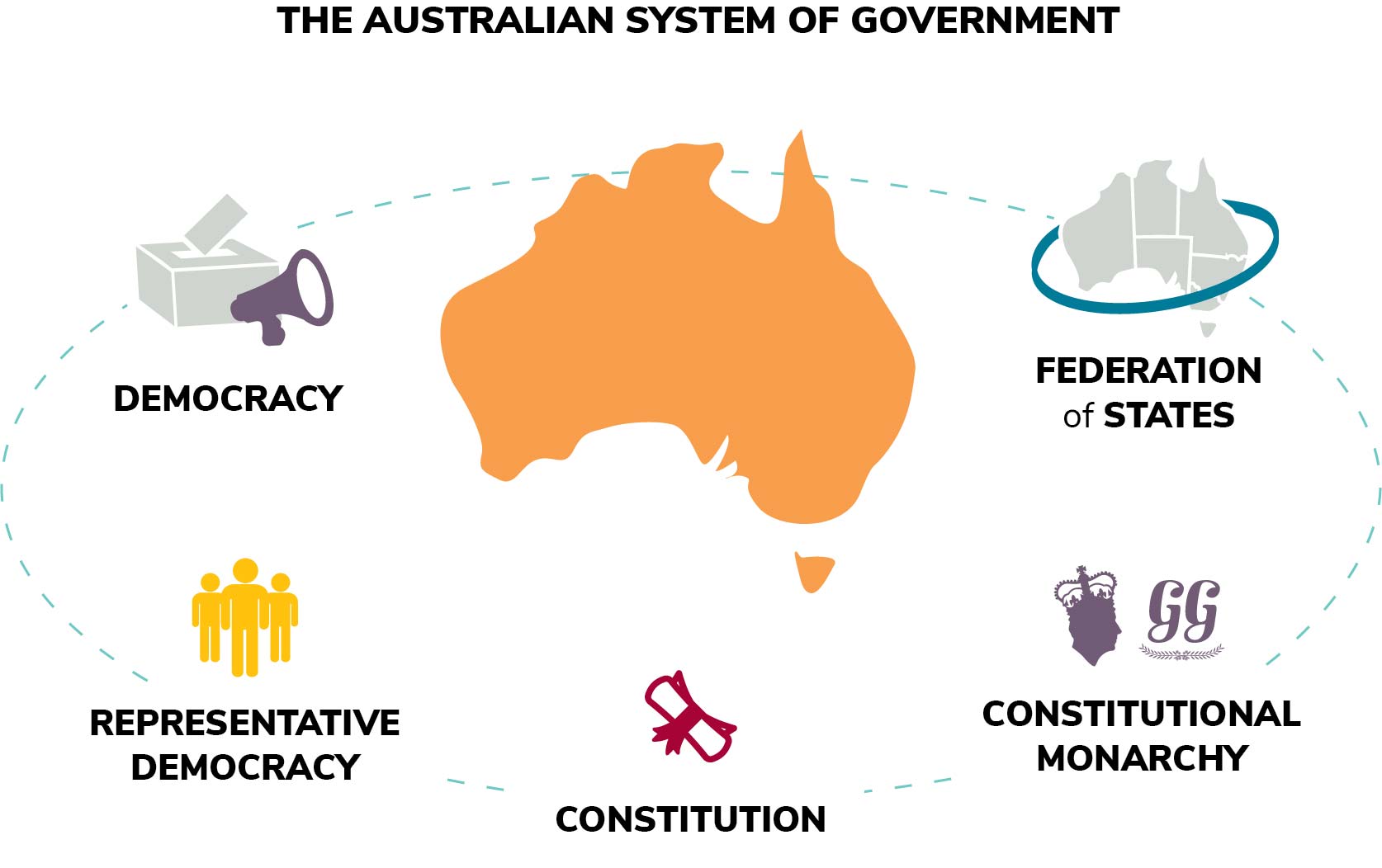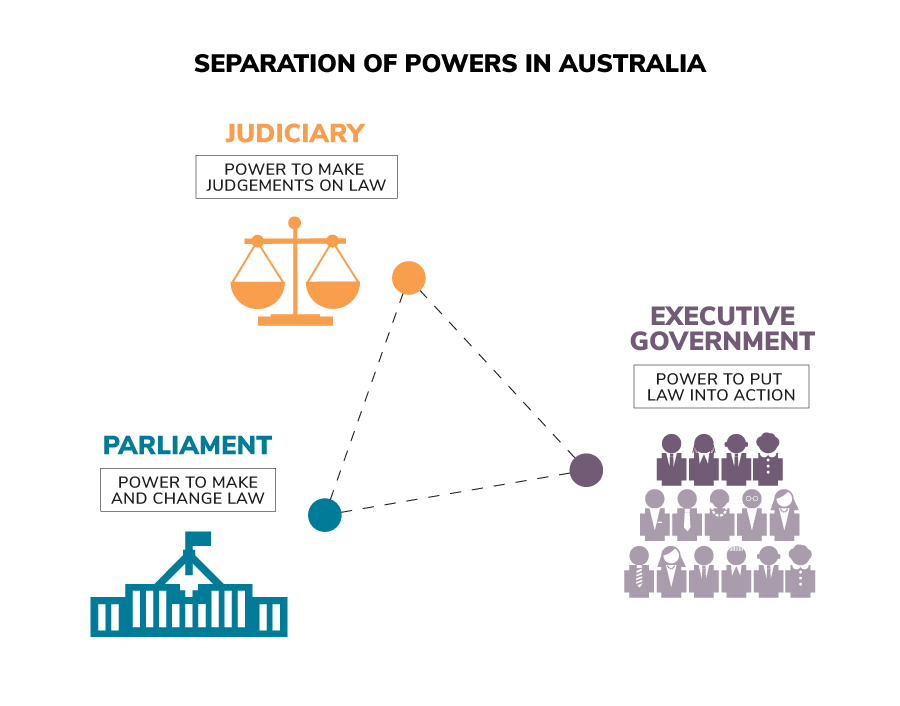Australian system of government
This fact sheet examines Australia’s system of government. It includes information about representative democracy, constitutional monarchy, federation and the separation of powers.
What will I learn?
- A system of government is the structure by which a country is run.
- Australia is a representative democracy, constitutional monarchy and a federation.
- The Australian Constitution sets out that the power to make and manage laws is shared amongst different groups in Australia.
A
Z
Glossary words
constitutional monarchy, federation, representative democracy, separation of powers
Curriculum alignment
Year 6 ACHASSK143
Year 7 ACHCK048
Year 10 ACHCK090
What is the Australian system of government?
A system of government is the structure by which a country is run. Australia is a representative democracy and a constitutional monarchy. It is also a federation of states. Many features of Australia’s system of government are based on the Westminster system.
Some examples of other systems of government are communism, dictatorship and republic.
Features
The key components of Australia’s system of government are:
- democracy
- representative democracy
- constitutional monarchy
- a federation of states
- an Australian Constitution which distributes the power to make and manage laws between the Parliament, the Executive and the Judiciary – this is known as the separation of powers.
The Australian system of government.

Parliamentary Education Office (PEO.GOV.AU)
Description
This graphic illustrates the 5 components of the Australian system of government:
- democracy
- representative democracy
- consitution
- constitutional monarchy
- federation of states
Copyright information
This work is licensed under a Creative Commons Attribution-NonCommercial-NoDerivs 3.0 Unported License.
You are free to share – to copy, distribute and transmit the work.
Attribution – you must attribute the work in the manner specified by the author or licensor (but not in any way that suggests that they endorse you or your use of the work).
Non-commercial – you may not use this work for commercial purposes.
No derivative works – you may not alter, transform, or build upon this work.
Waiver – any of the above conditions can be waived if you get permission from the copyright holder.
The Australian system of government.

Parliamentary Education Office (PEO.GOV.AU)
Description
This graphic illustrates the 5 components of the Australian system of government:
- democracy
- representative democracy
- consitution
- constitutional monarchy
- federation of states
Copyright information
This work is licensed under a Creative Commons Attribution-NonCommercial-NoDerivs 3.0 Unported License.
You are free to share – to copy, distribute and transmit the work.
Attribution – you must attribute the work in the manner specified by the author or licensor (but not in any way that suggests that they endorse you or your use of the work).
Non-commercial – you may not use this work for commercial purposes.
No derivative works – you may not alter, transform, or build upon this work.
Waiver – any of the above conditions can be waived if you get permission from the copyright holder.
Democracy
Democracy means rule by the people. The word comes from the ancient Greek words ‘demos’ (the people) and ‘kratos’ (to rule). A democratic country has a system of government where people have the power to participate in decision-making.
Representative democracy
In a representative democracy, citizens choose people to represent them in a parliament. In Australia, federal elections are held approximately every 3 years to select members of parliament who will represent Australians and make laws on their behalf.
Examples of other representative democracies include the United States, the United Kingdom and Argentina.
Constitutional monarchy
In a constitutional monarchy a king or queen is the head of state but has limited power. They must follow the country’s constitution and follow accepted practices known as conventions. Australia's head of state is His Majesty King Charles III. The Governor-General is appointed to act on behalf of the King in Australia.
Examples of other constitutional monarchies include Belgium, Tonga and Sweden.
Federation of states
A federation is a group of states that have joined together to form a single country. In 1901, 6 British colonies agreed to form the country of Australia. The colonies became Australian states and a federal – Australian – Parliament was created. The Australian Parliament has the power to make laws about national matters such as defence, immigration, trade and foreign affairs. The Australian Constitution – the set of rules by which Australia is run – sets out how the Australian and state parliaments share the power to make laws.
Three levels of government work together to make laws that provide Australians with the services they need. The three levels are:
- Australian Parliament, in Canberra
- state and territory parliaments, in each state and territory capital city
- local councils – also called shires – across Australia.
Examples of other federations include Canada, India and Germany.
Separation of powers in Australia.

Parliamentary Education Office (peo.gov.au)
Description
This diagram illustrates the separation of powers in the Australian system of government. The Parliament (represented by an icon of Australian Parliament House) has the power to make and change law. The Executive (represented by a group of people) has the power to put law into action. The Judiciary (represented by an icon of a scale) has the power to make judgements on law. The three groups—Parliament, Executive and Judiciary—are connected.
Copyright information
This work is licensed under a Creative Commons Attribution-NonCommercial-NoDerivs 3.0 Unported License.
You are free to share – to copy, distribute and transmit the work.
Attribution – you must attribute the work in the manner specified by the author or licensor (but not in any way that suggests that they endorse you or your use of the work).
Non-commercial – you may not use this work for commercial purposes.
No derivative works – you may not alter, transform, or build upon this work.
Waiver – any of the above conditions can be waived if you get permission from the copyright holder.
Separation of powers in the Australian Constitution
The Constitution defines 3 groups—the Parliament, the Executive and the Judiciary—and describes how they share power. The separation of powers helps to make sure that no group has all the power. Each group has their own area of responsibility:
- Parliament (the legislature) makes and changes the law,
- the Executive puts the law into action,
- the Judiciary settles disputes about the law.
Examples of other countries that separate the Parliament, Executive and Judiciary include New Zealand, the Philippines and South Africa.
